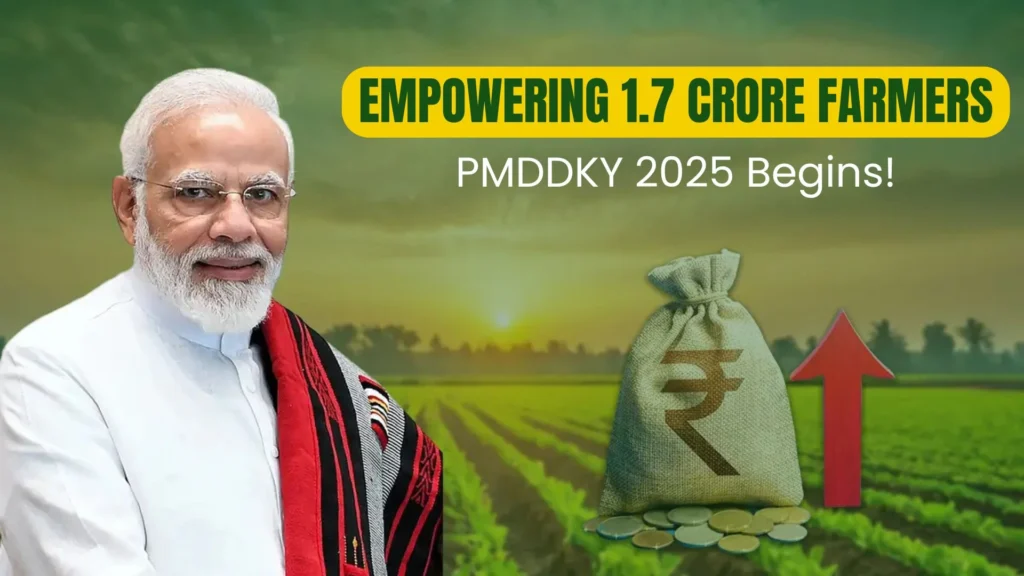
When Ramesh first saw a government notice pinned to the village board, he thought it was just another headline. Two seasons later, after joining local training under PMDDKY, his lentil harvest doubled — and his family could finally breathe easy.

India’s food distribution network depends not only on fair procurement and storage but on building stronger production systems at the district level. The Pradhan Mantri Dhan-Dhaanya Krishi Yojana (PMDDKY) is a recent national initiative aimed at exactly that: increasing agricultural productivity, strengthening value chains, and supporting districts with low yields to become self-reliant in food grains and pulses. This guide explains what PMDDKY is, who benefits, how it links to food distribution, and how stakeholders — from village ration dealers to district food officers — can use the scheme to improve supply stability.
What is PMDDKY?
PMDDKY (Pradhan Mantri Dhan-Dhaanya Krishi Yojana) is a centrally-sponsored programme approved by the Union Cabinet in mid-2025 to transform agricultural outcomes in 100 selected districts across India. The scheme emphasizes saturation-level convergence of central schemes, investments in infrastructure, and capacity building for farmers over a multi-year period. The reported outlay is ₹24,000 crore per year to be deployed over several years for district-level interventions.
Why PMDDKY matters for food distribution
Food distribution (PDS, procurement, buffer stocking) begins with what farmers produce. Gaps in local production force greater central procurement and complex logistics. PMDDKY targets districts with low productivity and weak credit access so that:
- Local production of staple cereals and pulses increases.
- Post-harvest losses fall due to better storage and market linkages.
- Value chains (processing, transport, FPOs) become stronger, easing the burden on public distribution logistics.
When a district shifts from chronic deficit to relative self-sufficiency, state food departments can redirect procurement budgets, improve buffer planning, and reduce emergency imports — all critical benefits for the PDS network.
Core objectives of PMDDKY
PMDDKY aims to:
- Raise crop productivity in selected districts through integrated interventions.
- Promote crop diversification, especially pulses and millets, to improve food and nutritional security.
- Build cold chain, storage, and processing infrastructure to lower losses and stabilize supplies.
- Link smallholders to markets and strengthen Farmer Producer Organizations (FPOs).
- Converge 30+ central schemes across ministries at district level for maximum impact.
Who is eligible and which districts are targeted?
Eligibility is district-based: the central government has identified 100 underperforming agricultural districts for saturation interventions. Within those districts, farmers who own or cultivate land and registered smallholders are prime beneficiaries. The district-level implementation committee will finalize participant lists and local interventions. This district-first approach ensures efforts benefit the largest number of small and marginal farmers and the food systems they feed.
Key components and interventions
PMDDKY bundles a wide set of supports — here are the headline interventions relevant to food distribution:
- Seed and input support: High-quality seeds, micro-nutrients, and linkages for climate-resilient varieties to raise per-hectare yields.
- Irrigation & water efficiency: Micro-irrigation and minor irrigation augmentation reduce crop risk and increase reliability.
- Post-harvest infrastructure: Community and district storages, warehouses, and cold chains to limit spoilage and enable staggered market sales that stabilize prices.
- Processing & value addition: Small processing units and linking to FPOs improve local procurement options.
- Market access & MSP linkages: Better aggregation points so that public procurement and private offtakes are more predictable.
- Training & extension: Farmer training in Good Agricultural Practices (GAP), integrated pest management, and crop diversification.
How PMDDKY links with the Public Distribution System (PDS)
Stronger district production and lower post-harvest loss means more reliable local supply for PDS procurement. Practically:
- State procurement can reduce transportation distances (lower costs).
- Districts can source pulses and cereals for local PDS requirements, increasing the share of locally produced food.
- Better storage reduces the need for emergency replenishment from far-off mandis.
For ration shop dealers and district food officers, PMDDKY provides an opportunity to collaborate with agriculture departments to plan seasonal procurement and storage usage.
Benefits For Farmers And Food-Distribution Actors
For farmers: higher yields, improved incomes through market linkages, access to technology and inputs, and reduced risks from post-harvest loss.
For food-distribution actors: more predictable supply, fewer spikes in procurement costs, and local options for buffer stocking — all reinforcing food security.
How implementation works at district level
PMDDKY is implemented through district committees that coordinate central and state schemes. These committees:
- Assess district-level gaps in production and storage.
- Design packages of interventions (seed distribution, irrigation, storage).
- Coordinate convergence of central schemes (eg. NABARD funding, rural development, horticulture, dairy) to avoid duplication.
- Engage with FPOs, cooperatives, and private sector partners for infrastructure.
Practical steps for farmers and stakeholders to access benefits
- Check district selection: Confirm if your district is among the 100 targeted areas (district list is published via district agriculture offices and government portals).
- Register locally: Many benefits require farmer registration or membership in local FPOs. Visit your Block or District Agriculture Office.
- Join training programs: Local extension camps and demonstration plots are often the first entry point.
- Aggregate via groups: FPOs and SHGs increase bargaining power for inputs, credit, and storage investment assistance.
- Use government helplines & portals: District portals and designated PMDDKY web pages will share application windows and local schemes.
Role of technology and data
PMDDKY emphasizes data-driven district planning: remote sensing for crop health, MIS for farmer beneficiary lists, and digital market platforms to connect producers and buyers. This reduces leakages and optimizes procurement planning for PDS authorities.
Private sector and PPP opportunities
The scheme encourages public-private partnerships for building storage, processing units, and aggregation centers. Private agritech and logistics companies can partner with district bodies and FPOs to design local supply chains that feed both markets and the PDS. This opens opportunities for local employment and better price realization for farmers.
Risks and challenges
- District selection limits reach: Only 100 districts are targeted initially; many needy districts remain outside the current phase.
- Coordination complexity: Converging many central schemes requires tight coordination between ministries and state departments.
- Implementation capacity: Districts need capable teams to plan and execute interventions effectively.
- Climate variability: Weather extremes may still threaten yields; adaptation measures must be prioritized.
What food distribution managers should do now
- Liaise with district agriculture officers to understand PMDDKY interventions and align procurement plans.
- Map local production forecasts against PDS requirements to anticipate shifts in local availability.
- Advocate for shared use of newly built storage (public & PMDDKY-funded) for PDS buffer needs.
- Engage with FPOs as aggregation partners to simplify procurement and reduce transaction costs.
Example: what success could look like
Imagine a district that previously imported 30% of its pulses for PDS. After 2 years under PMDDKY, local pulse production rises by 40%, community warehouses cut losses by 15%, and the district can source a majority of its PDS pulse requirement locally. This lowers transport costs, stabilizes supplies, and improves diets for beneficiaries.
FAQ (quick answers)
When the fair-price shop ran out of lentils last year, the community suffered; this season, after small farmers pooled into an FPO under PMDDKY, the same shop stocked local pulses — and the line of hungry neighbors disappeared. That is the kind of change PMDDKY aims to scale.
For official government services, please visit: www.pib.gov.in
Visit this page to learn more about this services: Aahar Jharkhand.
